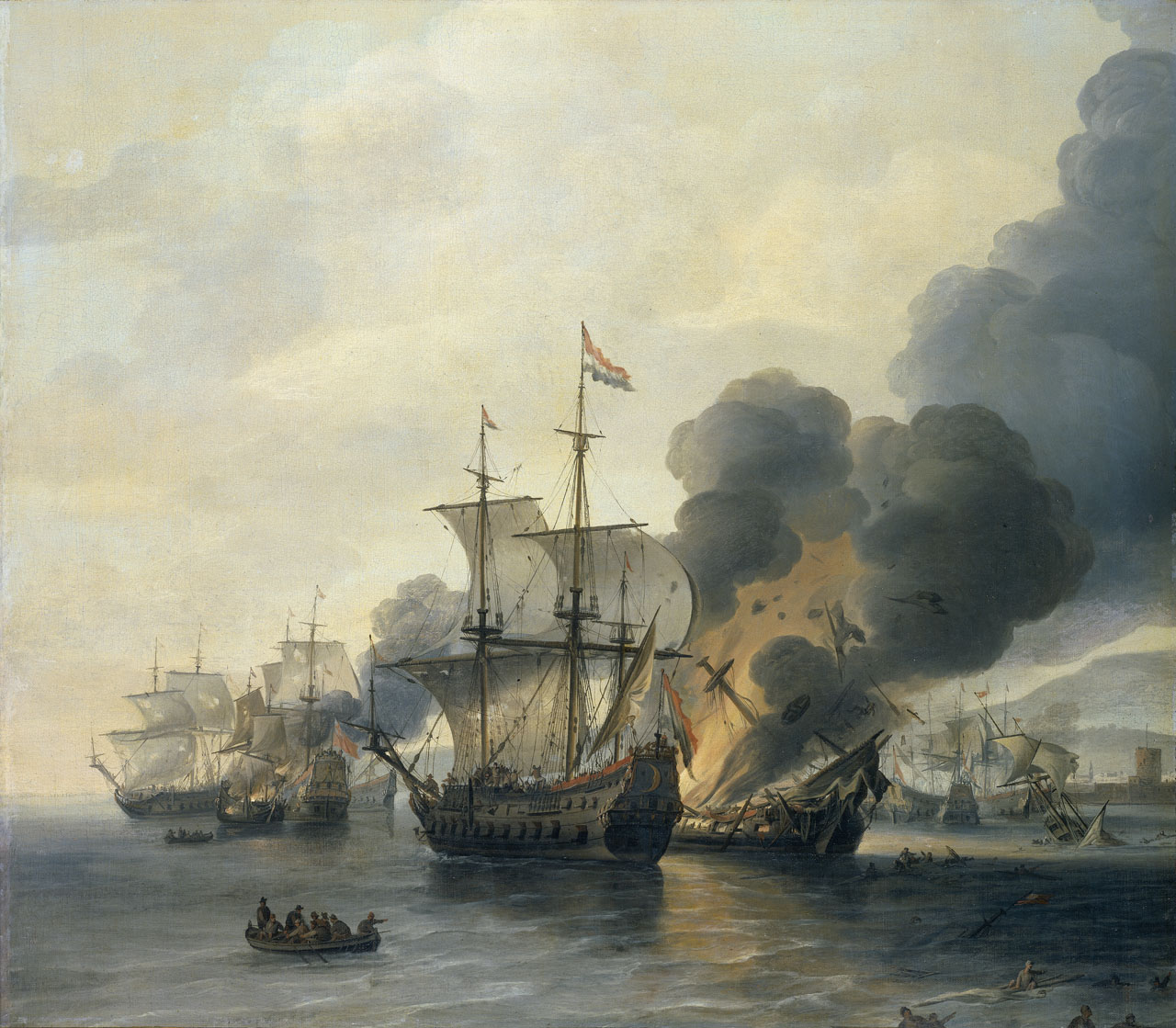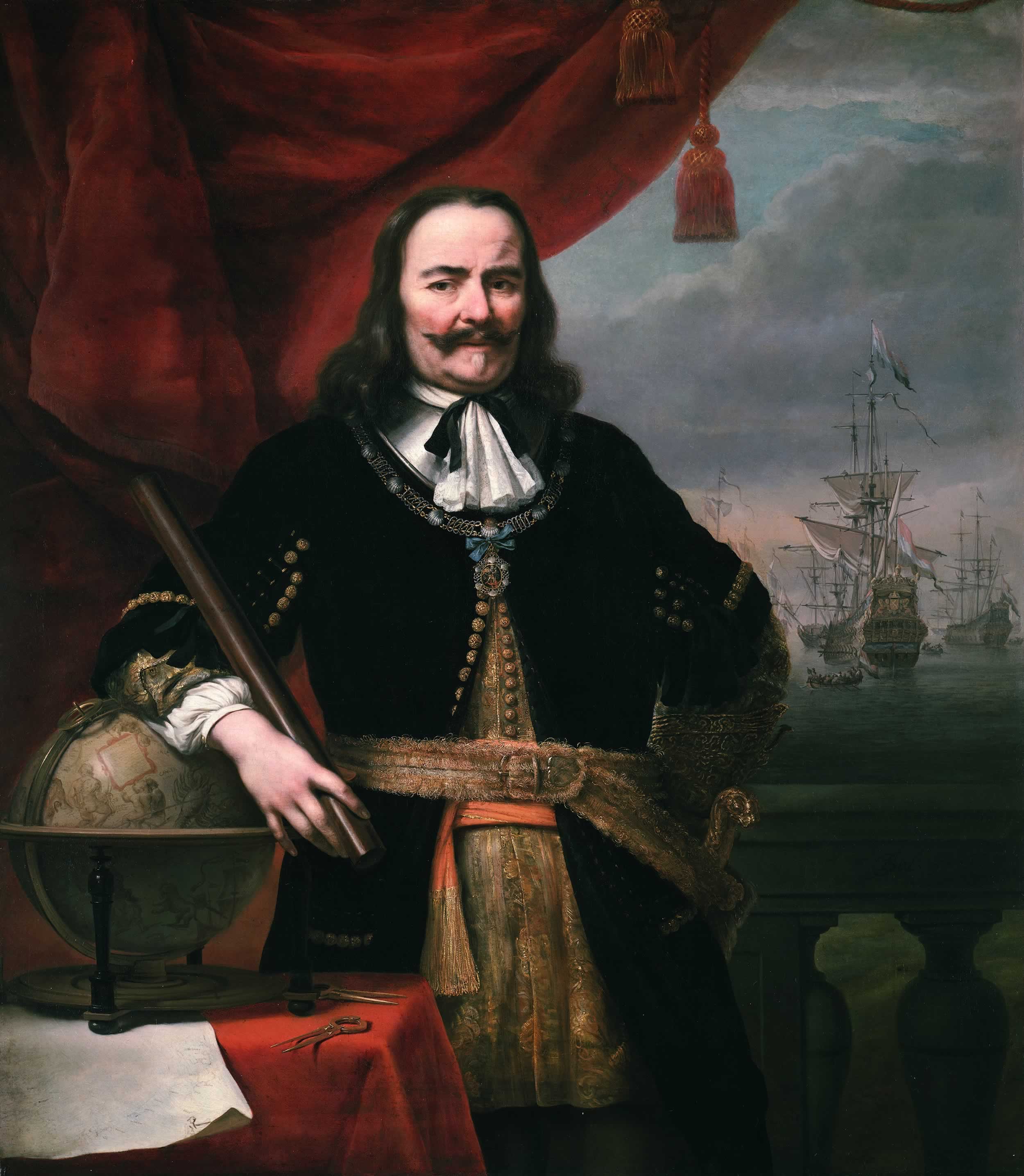|
Willem Bastiaensz Schepers
Willem Bastiaensz Schepers (8 October 1619 – 21 January 1704) was a Dutch admiral. Having made his career as a shipping magnate in Rotterdam, Schepers was rewarded in 1673 for his political support to the new Orangist regime, by being made lieutenant admiral. In 1688, he organised the transport fleet for the Glorious Revolution. Biography Schepers was the son of a sailmaker in Haarlem. On 28 May 1641, he is recorded in Rotterdam as a merchant marrying Bartha de Jong, the daughter of an owner of herring busses in Delfshaven. For the year 1659, Schepers was for the first time in Rotterdam appointed as treasurer of the "Great Fishery", or herring fleet, an office he would hold in several subsequent years. Schepers accumulated much wealth as a ship owner and gained political influence. During this period, in the Dutch Republic political power was contested between the ruling States faction and the Organgists who wanted to make William III of Orange stadtholder. In the ... [...More Info...] [...Related Items...] OR: [Wikipedia] [Google] [Baidu] |
Haarlem
Haarlem (; predecessor of ''Harlem'' in English) is a city and municipality in the Netherlands. It is the capital of the province of North Holland. Haarlem is situated at the northern edge of the Randstad, one of the most populated metropolitan areas in Europe; it is also part of the Amsterdam metropolitan area, being located about 15 km to the west of the core city of Amsterdam. Haarlem had a population of in . Haarlem was granted city status or '' stadsrechten'' in 1245, although the first city walls were not built until 1270. The modern city encompasses the former municipality of Schoten as well as parts that previously belonged to Bloemendaal and Heemstede. Apart from the city, the municipality of Haarlem also includes the western part of the village of Spaarndam. Newer sections of Spaarndam lie within the neighbouring municipality of Haarlemmermeer. Geography Haarlem is located on the river Spaarne, giving it its nickname 'Spaarnestad' (Spaarne city). It is ... [...More Info...] [...Related Items...] OR: [Wikipedia] [Google] [Baidu] |
Rampjaar
In Dutch history, the year 1672 is referred to as the nl, Rampjaar, label=none (Disaster Year). In May 1672, following the outbreak of the Franco-Dutch War and its peripheral conflict the Third Anglo-Dutch War, France, supported by Münster and Cologne, invaded and nearly overran the Dutch Republic. At the same time, it faced the threat of an English naval blockade in support of the French endeavor, though that attempt was abandoned following the Battle of Solebay. A Dutch saying coined that year describes the Dutch people as ("irrational"), its government as ("distraught"), and the country as ("beyond salvation"). The cities of the coastal provinces of Holland, Zealand and Frisia underwent a political transition: the city governments were taken over by Orangists, opposed to the republican regime of the Grand Pensionary Johan de Witt, ending the First Stadtholderless Period. By late July however, the Dutch position had stabilised, with support from Holy Roman Emperor ... [...More Info...] [...Related Items...] OR: [Wikipedia] [Google] [Baidu] |
Cornelis Tromp
Cornelis Maartenszoon Tromp, ''Count of Sølvesborg'' (3 September 1629 – 29 May 1691) was a Dutch naval officer who served as lieutenant-admiral general in the Dutch Navy, and briefly as a general admiral in the Royal Danish Navy. Tromp fought in the Anglo-Dutch Wars and the Scanian War. His father was Lieutenant Admiral Maarten Tromp. Biography Early life Cornelis Maartenszoon Tromp was born on 9 September 1629, in Rotterdam, in the historically dominant county of Holland. He was the second son of Maarten Tromp and Dina Cornelisdochter de Haas. His name Maartenszoon, sometimes abbreviated to Maartensz, is a patronymic. He had two full brothers, Harper and Johan.Tromp, Cornelis in ''Nieuw Nederlandsch biografisch woordenboek. Deel 5''. Retrieved 5 May 2009. In 1633, when he was only fou ... [...More Info...] [...Related Items...] OR: [Wikipedia] [Google] [Baidu] |
Christian V Of Denmark
Christian V (15 April 1646 25 August 1699) was king of Denmark and Norway from 1670 until his death in 1699. Well-regarded by the common people, he was the first king anointed at Frederiksborg Castle chapel as absolute monarch since the decree that institutionalized the supremacy of the king in Denmark-Norway. Christian fortified the absolutist system against the aristocracy by accelerating his father's practice of allowing both Holstein nobles and Danish and Norwegian commoners into state service. As king, he wanted to show his power as absolute monarch through architecture, and dreamed of a Danish Versailles. He was the first to use the 1671 Throne Chair of Denmark, partly made for this purpose. His motto was: ''Pietate et Justitia'' (With piety and justice). Biography Early years Prince Christian was born on 15 April 1646 at Duborg Castle in the city of Flensburg, then located in the Duchy of Schleswig. He was the first legitimate child born to the then Prince Fr ... [...More Info...] [...Related Items...] OR: [Wikipedia] [Google] [Baidu] |
Dunkirk
Dunkirk (french: Dunkerque ; vls, label= French Flemish, Duunkerke; nl, Duinkerke(n) ; , ;) is a commune in the department of Nord in northern France.Commune de Dunkerque (59183) INSEE It lies from the Belgian border. It has the third-largest French harbour. The population of the commune in 2019 was 86,279. Etymology and language use The name of Dunkirk derives from West Flemish '' or ' dun' and 'church', thus 'church in the dune ...[...More Info...] [...Related Items...] OR: [Wikipedia] [Google] [Baidu] |
Jan Jansse Van Nes
Jan Janszoon van Nes (26 April 1631 – ) was a Dutch admiral and brother of naval commander Aert Janszoon van Nes. They both took part in the Raid on the Medway of 1667. He was buried in the Grote of Sint-Laurenskerk (Rotterdam) Church. Bibliography * * {{DEFAULTSORT:Nes, Jan Jansse van 1631 births 1680 deaths Admirals of the navy of the Dutch Republic Dutch naval personnel of the Anglo-Dutch Wars Military personnel from Rotterdam ... [...More Info...] [...Related Items...] OR: [Wikipedia] [Google] [Baidu] |
House Of Orange
The House of Orange-Nassau ( Dutch: ''Huis van Oranje-Nassau'', ) is the current reigning house of the Netherlands. A branch of the European House of Nassau, the house has played a central role in the politics and government of the Netherlands and Europe especially since William the Silent organised the Dutch Revolt against Spanish rule, which after the Eighty Years' War (1568–1648) led to an independent Dutch state. Several members of the house served during this war and after as stadtholder ("governor"; Dutch: ''stadhouder'') during the Dutch Republic. However, in 1815, after a long period as a republic, the Netherlands became a monarchy under the House of Orange-Nassau. The dynasty was established as a result of the marriage of Henry III of Nassau-Breda from Germany and Claudia of Châlon-Orange from French Burgundy in 1515. Their son René of Chalon inherited in 1530 the independent and sovereign Principality of Orange from his mother's brother, Philibert of Châ ... [...More Info...] [...Related Items...] OR: [Wikipedia] [Google] [Baidu] |
Perpetual Edict (1667)
The Perpetual Edict (Dutch: ''Eeuwig Edict'') was a resolution of the States of Holland passed on 5 August 1667 which abolished the office of Stadtholder in the province of Holland. At approximately the same time, a majority of provinces in the States General of the Netherlands agreed to declare the office of stadtholder (in any of the provinces) incompatible with the office of Captain general of the Dutch Republic. Background During the First Stadtholderless Period, the States-Party faction of the Dutch Regents, led by Grand Pensionary Johan de Witt and his nephew Cornelis de Graeff, tried to prevent the elevation of young William III, Prince of Orange to the office of Stadtholder in the province of Holland. After the Treaty of Westminster (1654) they enacted the Act of Seclusion, which would prevent a member of the House of Orange being appointed to the office, without abolishing the office itself. This Act was revoked in 1660, after the Restoration of William's uncle Cha ... [...More Info...] [...Related Items...] OR: [Wikipedia] [Google] [Baidu] |
Jan Meppel
Jan Corneliszoon Meppel ( – 2 November 1669) was a Dutch admiral who took the place of Pieter Floriszoon after his death. He fought in the Four Days' Battle, the St. James's Day Battle, and the Raid on the Medway The Raid on the Medway, during the Second Anglo-Dutch War in June 1667, was a successful attack conducted by the Dutch navy on English warships laid up in the fleet anchorages off Chatham Dockyard and Gillingham in the county of Kent. At .... {{DEFAULTSORT:Meppel, Jan 17th-century Dutch people 1610s births 1669 deaths Admirals of the navy of the Dutch Republic Dutch naval personnel of the Anglo-Dutch Wars People from Hoorn Year of birth uncertain ... [...More Info...] [...Related Items...] OR: [Wikipedia] [Google] [Baidu] |
Admiralty Of The Noorderkwartier
The Admiralty of the Noorderkwartier (Dutch, 'Northern Quarter'), also known as the Admiralty of West Friesland, was one of the five admiralties of the Dutch Republic, made up of West Friesland, a region in the north of the province of Holland. History It was set up on 6 March 1589 by a resolution of the Parliament of the Netherlands, via a decision of the Stadholder Maurits of Orange. It was established at Hoorn (and in Enkhuizen Enkhuizen () is a municipality and a city in the Netherlands, in the province of North Holland and the region of West-Frisia. History Enkhuizen, like Hoorn and Amsterdam, was one of the harbor-towns of the VOC, from where overseas trade ... for about three months in 1597). The admiralty was disestablished in 1795. Fleet guardians Known fleet guardians of the admiralty include: External linksAdmiraliteit van het Noorderkwartier 1589 establishments in the Dutch Republic 1795 disestablishments Noorderkwartier History of Nort ... [...More Info...] [...Related Items...] OR: [Wikipedia] [Google] [Baidu] |
Battle Of Texel
The naval Battle of Texel or Battle of Kijkduin took place off the southern coast of island of Texel on 21 August 1673 (11 August O.S.) between the Dutch and the combined English and French fleets. It was the last major battle of the Third Anglo-Dutch War, which was itself part of the Franco-Dutch War (1672–1678), during which Louis XIV of France invaded the Republic and sought to establish control over the Spanish Netherlands. English involvement came about because of the Treaty of Dover, secretly concluded by Charles II of England, and which was highly unpopular with the English Parliament. The overall commanders of the English and Dutch military forces were Lord High Admiral James, Duke of York, later James II, and Admiral-General William III of Orange, his son-in-law and another future King of England. Neither of them took part in the fight. Prince Rupert of the Rhine commanded the Allied fleet of about 92 ships and 30 fireships, taking control of the centre himself, wit ... [...More Info...] [...Related Items...] OR: [Wikipedia] [Google] [Baidu] |
Burgomaster
Burgomaster (alternatively spelled burgermeister, literally "master of the town, master of the borough, master of the fortress, master of the citizens") is the English form of various terms in or derived from Germanic languages for the chief magistrate or executive of a city or town. The name in English was derived from the Dutch ''burgemeester''. In some cases, Burgomaster was the title of the head of state and head of government of a sovereign (or partially or de facto sovereign) city-state, sometimes combined with other titles, such as Hamburg's First Mayor and President of the Senate). Contemporary titles are commonly translated into English as '' mayor''. Historical use * The title "burgermeister" was first used in the early 13th century. *In history (sometimes until the beginning of the 19th century) in many free imperial cities (such as Bremen, Hamburg, Lübeck etc.) the function of burgomaster was usually held simultaneously by three persons, serving as an execut ... [...More Info...] [...Related Items...] OR: [Wikipedia] [Google] [Baidu] |






